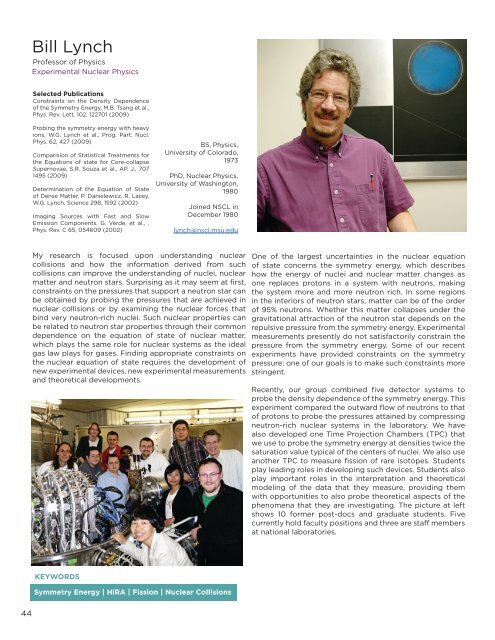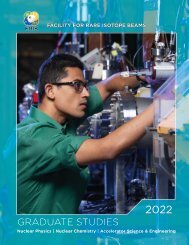2021FRIB/NSCL Graduate Brochure
You also want an ePaper? Increase the reach of your titles
YUMPU automatically turns print PDFs into web optimized ePapers that Google loves.
Bill Lynch<br />
Professor of Physics<br />
Experimental Nuclear Physics<br />
Selected Publications<br />
Constraints on the Density Dependence<br />
of the Symmetry Energy, M.B. Tsang et al.,<br />
Phys. Rev. Lett. 102, 122701 (2009)<br />
Probing the symmetry energy with heavy<br />
ions, W.G. Lynch et al., Prog. Part. Nucl.<br />
Phys. 62, 427 (2009)<br />
Comparision of Statistical Treatments for<br />
the Equations of state for Core-collapse<br />
Supernovae, S.R. Souza et al., AP. J., 707<br />
1495 (2009)<br />
Determination of the Equation of State<br />
of Dense Matter, P. Danielewicz, R. Lacey,<br />
W.G. Lynch, Science 298, 1592 (2002)<br />
Imaging Sources with Fast and Slow<br />
Emission Components, G. Verde, et al., ,<br />
Phys. Rev. C 65, 054609 (2002)<br />
BS, Physics,<br />
University of Colorado,<br />
1973<br />
PhD, Nuclear Physics,<br />
University of Washington,<br />
1980<br />
Joined <strong>NSCL</strong> in<br />
December 1980<br />
lynch@nscl.msu.edu<br />
My research is focused upon understanding nuclear<br />
collisions and how the information derived from such<br />
collisions can improve the understanding of nuclei, nuclear<br />
matter and neutron stars. Surprising as it may seem at first,<br />
constraints on the pressures that support a neutron star can<br />
be obtained by probing the pressures that are achieved in<br />
nuclear collisions or by examining the nuclear forces that<br />
bind very neutron-rich nuclei. Such nuclear properties can<br />
be related to neutron star properties through their common<br />
dependence on the equation of state of nuclear matter,<br />
which plays the same role for nuclear systems as the ideal<br />
gas law plays for gases. Finding appropriate constraints on<br />
the nuclear equation of state requires the development of<br />
new experimental devices, new experimental measurements<br />
and theoretical developments.<br />
One of the largest uncertainties in the nuclear equation<br />
of state concerns the symmetry energy, which describes<br />
how the energy of nuclei and nuclear matter changes as<br />
one replaces protons in a system with neutrons, making<br />
the system more and more neutron rich. In some regions<br />
in the interiors of neutron stars, matter can be of the order<br />
of 95% neutrons. Whether this matter collapses under the<br />
gravitational attraction of the neutron star depends on the<br />
repulsive pressure from the symmetry energy. Experimental<br />
measurements presently do not satisfactorily constrain the<br />
pressure from the symmetry energy. Some of our recent<br />
experiments have provided constraints on the symmetry<br />
pressure; one of our goals is to make such constraints more<br />
stringent.<br />
Recently, our group combined five detector systems to<br />
probe the density dependence of the symmetry energy. This<br />
experiment compared the outward flow of neutrons to that<br />
of protons to probe the pressures attained by compressing<br />
neutron-rich nuclear systems in the laboratory. We have<br />
also developed one Time Projection Chambers (TPC) that<br />
we use to probe the symmetry energy at densities twice the<br />
saturation value typical of the centers of nuclei. We also use<br />
another TPC to measure fission of rare isotopes. Students<br />
play leading roles in developing such devices. Students also<br />
play important roles in the interpretation and theoretical<br />
modeling of the data that they measure, providing them<br />
with opportunities to also probe theoretical aspects of the<br />
phenomena that they are investigating. The picture at left<br />
shows 10 former post-docs and graduate students. Five<br />
currently hold faculty positions and three are staff members<br />
at national laboratories.<br />
KEYWORDS<br />
Symmetry Energy | HiRA | Fission | Nuclear Collisions<br />
44






